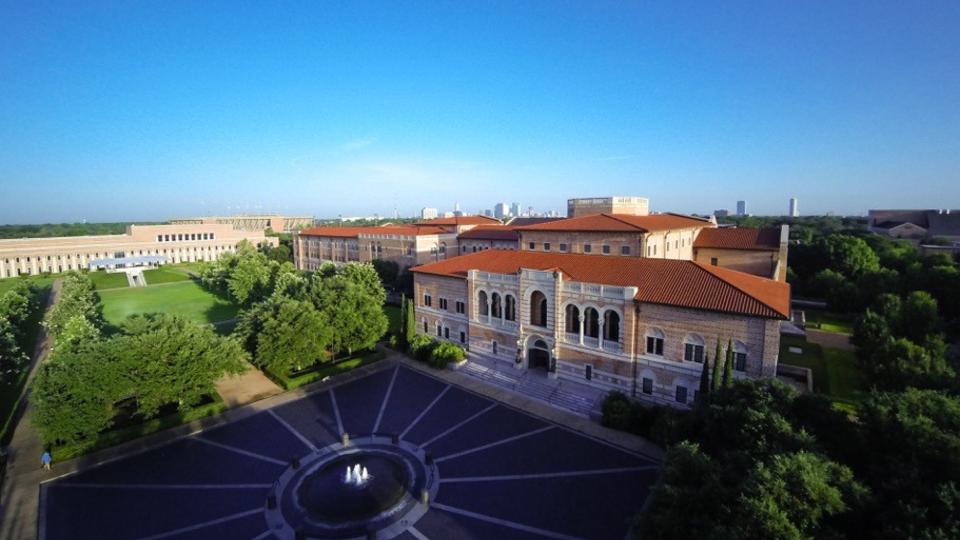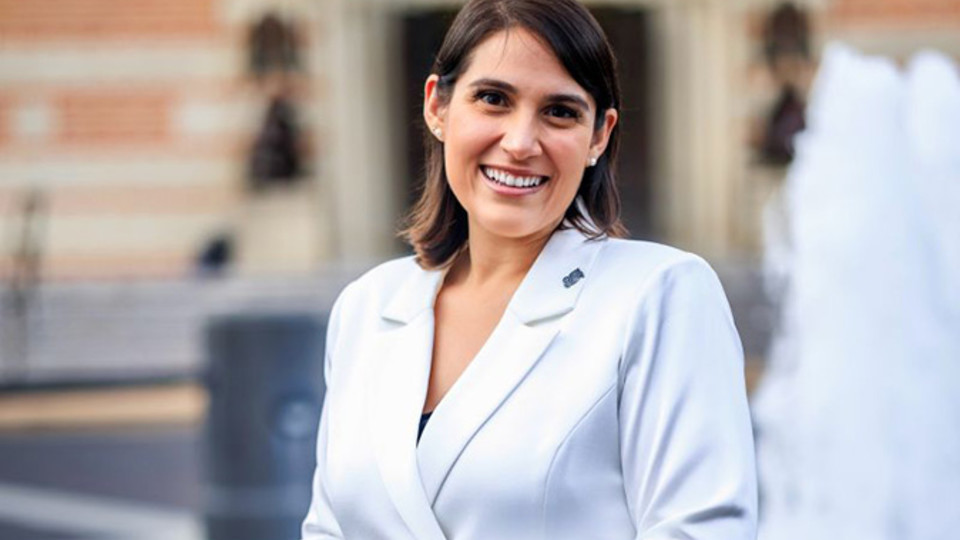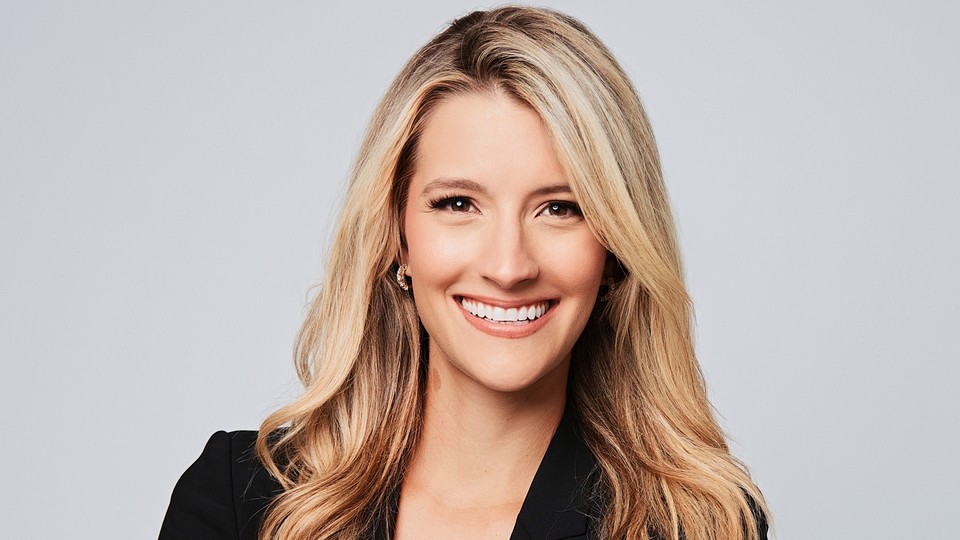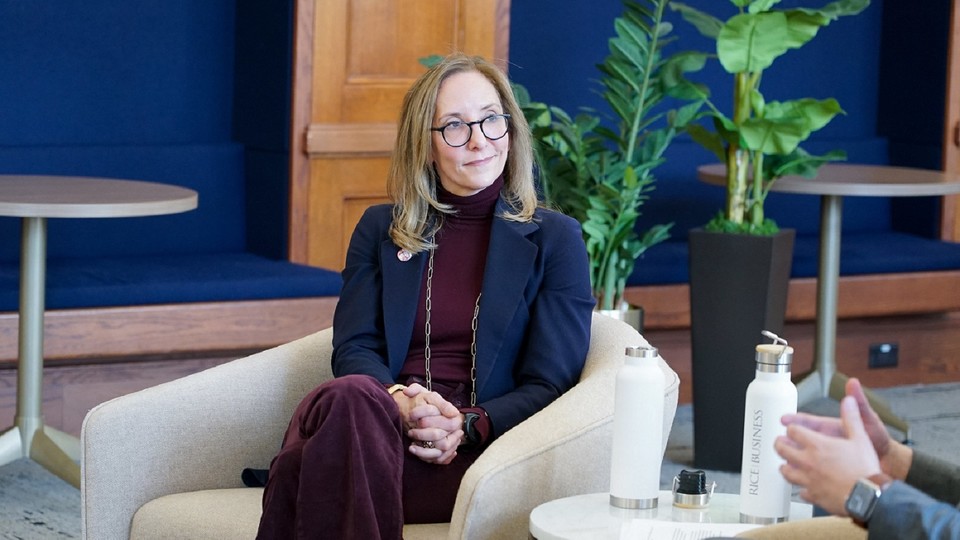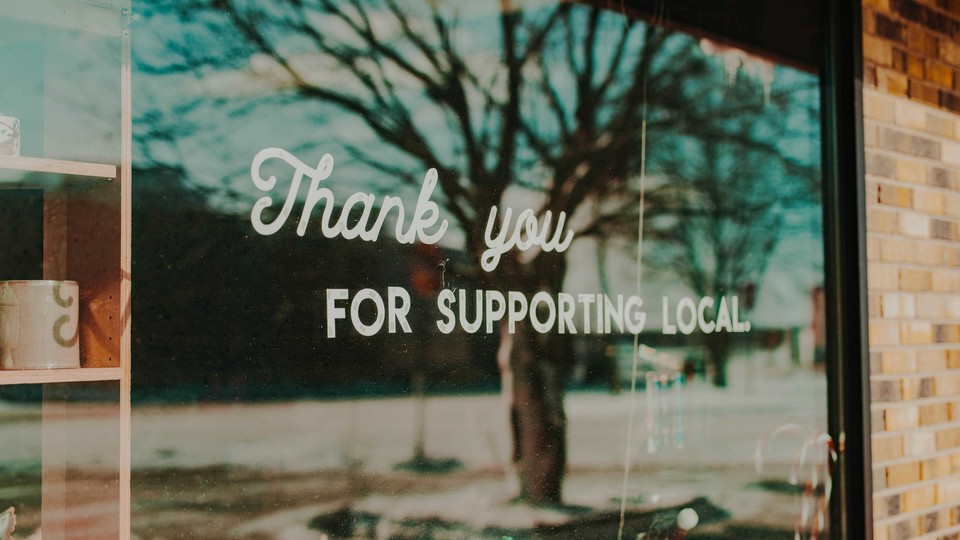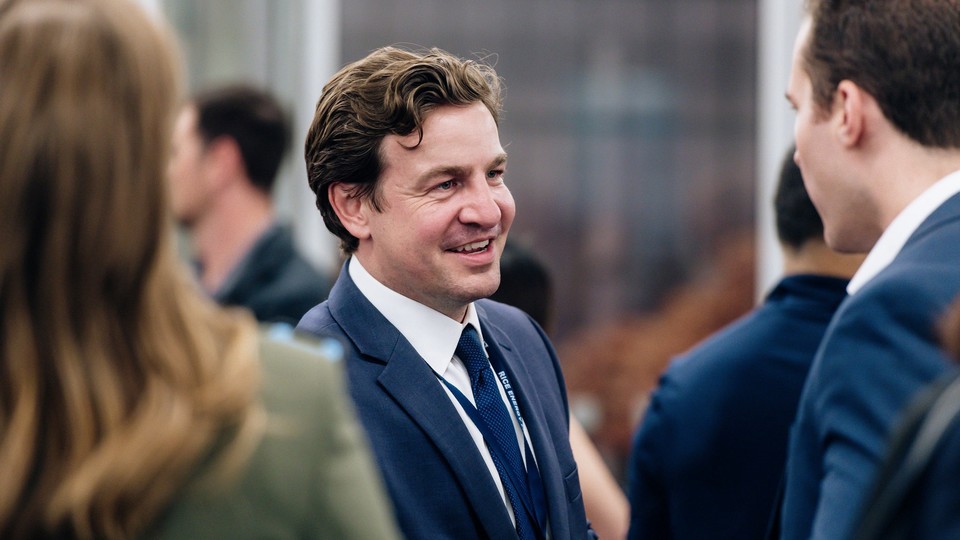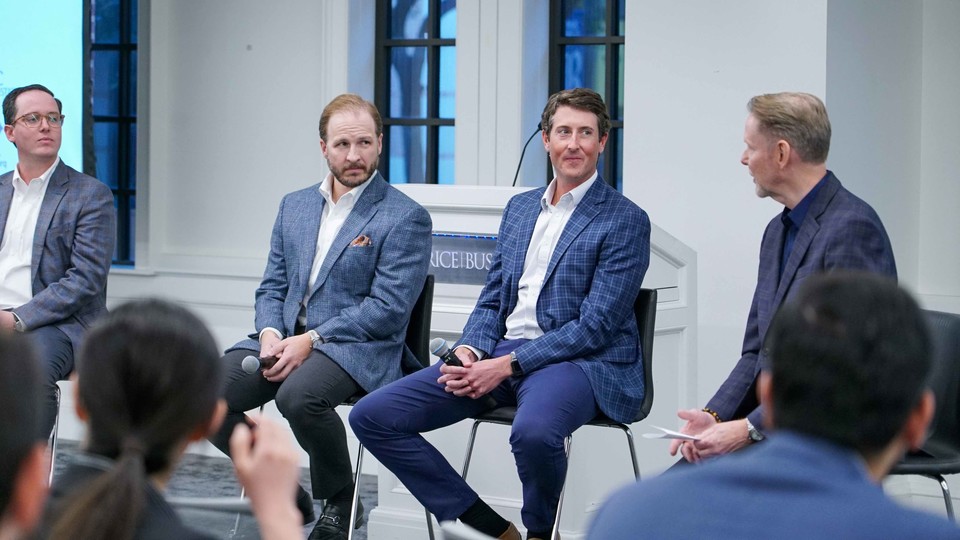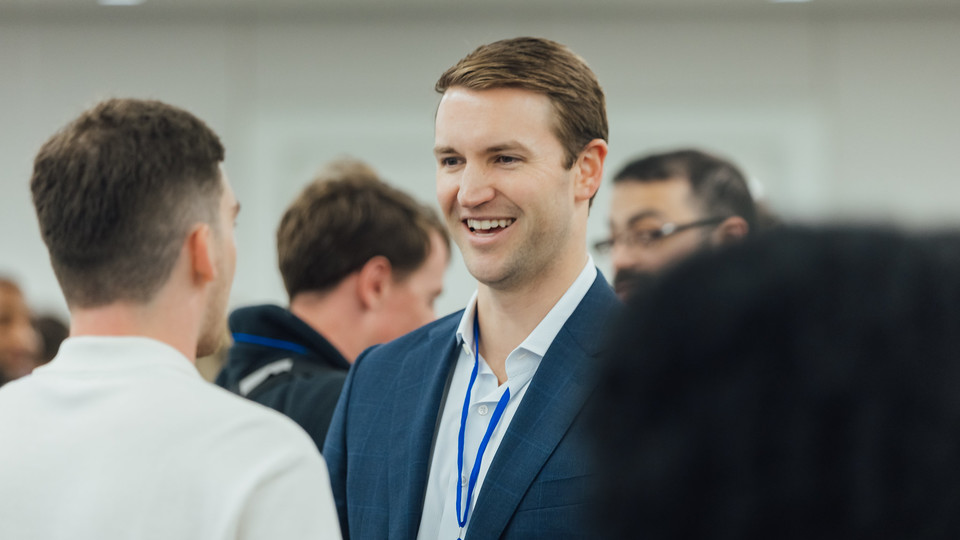What Is My Purpose Here? feat. Mike Dey ’20
Season 3, Episode 6
Mike Dey '20 talks with host Maya Pomroy '22 about building a cohort community in the online MBA program, how Rice Business inspired him to pivot from avionics engineering to business ownership and the importance of networking and connections.
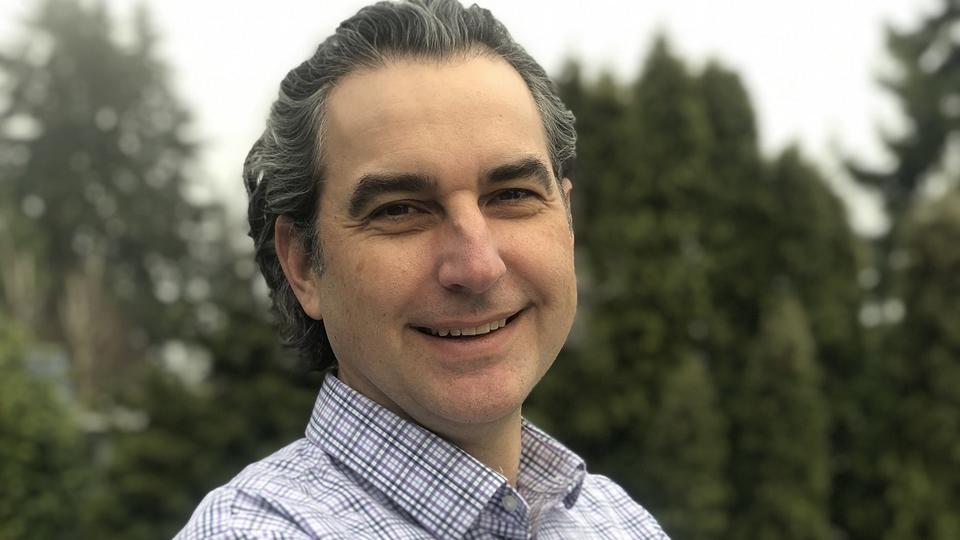
Owl Have You Know
Season 3, Episode 6
Mike Dey ‘20 talks with host Maya Pomroy '22 about building a cohort community in the online MBA program, how Rice Business inspired him to pivot from avionics engineering to business ownership and the importance of networking and connections.
Subscribe to Owl Have You Know on Apple Podcasts, Spotify, Youtube or wherever you find your favorite podcasts.
Episode Transcript
-
[00:00] Intro: Welcome to Owl Have You Know, a podcast from Rice Business. This episode is part of our Pivot Series, where guests share stories of transformation in their lives and careers.
[00:12] Mike: That's super attractive to somebody. The idea of doing your own thing and having your own little domain that you're totally responsible for is pretty exciting, compared to kind of that frustration, sometimes, of large organizations and the politics and the bureaucracy.
[00:32] Maya: Today on Owl Have You Know, we visit with Mike Dey, online MBA from the class of 2020. A Houston native, he received a BS in Aerospace Engineering from the University of Colorado Boulder, and began his career as an engineer for a flight crew operations integration at Boeing in 1996. So, really, you're a rocket scientist, right?
[00:53] Mike: I wouldn't say that, Maya.
[00:55] Maya: But close. But close. So, you designed an integrated commercial aircraft flight deck alerting and communication systems and worked on all of the Boeing models, with a focus on the 777, the triple seven, and the 737-NG. And I don't know what that means, but I'm sure that you can explain the differences to me. In 1999, you became a systems engineer and project manager at Universal Avionics Systems Corporation, where you implemented system design, test, and certifications for avionics hardware and software. And following your time at Universal Avionics Systems Corp., which I'm sure there's an acronym for that, you were turned back to Boeing for an impressive 15-year career and progressed from lead engineer of flight crew operations to manager of the 787 flight deck, to manager of the flight deck production development, to regional director of feature strategy, to senior manager of BCA features strategy and business development. And initially, you wanted to go back and get your MBA to advance your existing corporate career, but you pivoted. And that is super-duper exciting, because while at Rice, you really weren't expecting to become an entrepreneur and purchase, acquire an existing company and completely switch directions from where you were in the past.
[02:15] Mike: Exactly right. That's a great summary.
[02:17] Maya: Okay. Well, tell me about why you decided, first of all, to go into aerospace engineering and what really, you know, sparked that interest for you. Do you come from a family with that sort of background of aerospace engineering?
[02:34] Mike: Yeah, absolutely. I grew up really interested in airplanes and anything mechanical. My dad is and was a helicopter pilot, flying to offshore oil rigs in Houston. And he and I used to go flying as a kid. And so, you know, I loved airplanes, growing up. I thought about maybe becoming a commercial pilot. But, for me, engineering just seemed like the natural path, and getting involved in aerospace was a way to, you know, combine that passion of aviation with what I was good at, which was kind of that mechanical engineering interest.
[03:07] Maya: So, tell me about your time at Boeing. What was that like?
[03:10] Mike: So, it was fantastic and a great career. I love the company. The people there are the best in the world at what they do. I had a love for the products and the way, the way the work goes. For me, it was really a dream job, coming out of college, because I had that interest in flying and the flight deck and how the pilots operate the airplane. And so, being asked to join the group that does that work was really a dream come true as, you know, a graduating senior coming out of, out of engineering school. So, it was really the right career path for me at the time.
[03:48] Maya: But at some point, you decided, you know what? I need to go back and get some more knowledge. There was something that you were looking for, obviously, because nobody just decides one day, you know what? I'm just going to go back to school, because that's a very daunting task for most people.
[04:05] Mike: Exactly. And, you know, a lot of engineers do get MBAs. And it was something that came up a lot among my, you know, my friends at work and was something that people talked about. But, for me, I never wanted to go back to school. I felt like it was so difficult to get that aerospace engineering degree. I kind of swore off any more schooling.
So, it was never really in my mind for those 20 years, you know, that I was progressing in the company. And then, as I got exposed to special projects and kind of was looking for something different, I think, in retrospect, I realized that I need kind of a new challenge every few years, something new to learn. And the way I was accomplishing that inside the company was looking for new assignments and gradually, you know, growing my breadth and experience working for different teams.
And through some of those special projects, I got exposed to the business side of the company, you know, everything from finance, to legal, to M&A, to strategy, marketing, and sales. And that really started to kind of light a spark for me, that I wanted to know more about, how does the company work? How did airplanes get sold and financed, and things like that? And so, that started to sort of put that wedge in that I realized I needed some additional education. Plus, it was recommended, by that time I was working in strategy for the company., and my leaders kind of said, "Most people who progress here do need a formal business education." And so, they kind of encouraged me and pushed me to seek an MBA.
[05:45] Maya: Interesting. So, it was people within the company. Well, little did they know that you taking that step would actually lead you to doing something completely different. The irony of that is not lost.
[05:57] Mike: Yeah. When, I started my MBA, you know, my intent was to stay with Boeing, you know, add to my toolkit and be ready for next assignments and whatever else my career... you know, wherever my career might take me. But I also had an open mind. And that's part of the reason why I chose Rice, was the online MBA program was just becoming available at the time I was searching. I was looking at schools outside of the Seattle area. I've been in Seattle the last 20 years. Because I was just interested in a broader exposure to people from other industries and backgrounds beyond kind of the tech aerospace culture here in Seattle, and having grown up in Houston and seeing the Rice program become available, it was just like it just really got me excited about the possibility. And so, I chose Rice or tried... you know, assumed I would apply and hopefully get in. And I did.
[06:53] Maya: Well, and it is. It's a, it's a very new program. And it was one of Dean Rodriguez', you know, initiatives, is to have this online program at Rice. So, that's actually a program that I looked into as well, because I thought that there was so much flexibility and opportunity. And then, with COVID, a lot of the in-person classes actually took the same page out of an online program. So, it was interesting, how that all worked out. And maybe, because Rice had their online program when COVID hit, there are other programs that were in-person programs became so successful, because they had that opportunity to build this online program. So, tell me about the online program and the connections that you made and how you were able to really meet professors and cultivate those relationships.
[07:47] Mike: Yeah, absolutely. I was looking for hybrid programs. I did want something that included an in-person component, which the Rice MBA does include the intensive weekend portions. And that was very important to me. I thought going into it. And it did turn out that way. But what most impressed me was how well, even over Zoom, those connections were formed among my cohort, you know, working on group projects remotely and spending the time together in class. It really was amazing how well everybody was connected.
And then, when we did end up meeting for those weekend intensives on campus, it was just that much more, you know, accelerated that we got to know one another, we would meet people from other cohorts. And so, I just... I was impressed and very much exceeded my expectations, as far as building that community and getting to know my cohort.
[08:47] Maya: So, I don't know if you had this experience, but I did, because we... because I was a class of '22. And so, we were the COVID cohort that started in 2020. And I had seen all of these people on Zoom in their little tiny boxes. And then, when I met them in person, I'm like, "Wow, you're a heck of a lot taller than I was expecting you to be." Did you have those sorts of experiences as well?
[09:08] Mike: Yeah, exactly, certainly taller than you expect. And everybody had... from what I've heard, had the same experience that Prof. Rountree, who teaches financial accounting, for some reason, his recorded videos, you think he's maybe not a person that is as tall as he is when you actually meet him. It's like, wow, you're way taller than I thought you were.
[09:27] Maya: Yeah, for sure. So, why did you choose Rice? Because there are other online programs that have been around a bit longer. Was it the Houston connection that you wanted to have? Or, what was it that made you choose Rice over other schools?
[09:44] Mike: Yeah, I definitely, as I said, wanted to get out of Seattle, if possible, for the exposure to different industries and people of different backgrounds. And I did look at schools around the country. A lot of the good business schools, top business schools, are starting to offer these programs. And I wasn't intentionally looking for Houston at the beginning. But when I saw that the Rice program had become available, it just quickly jumped to the top of the list because of the reputation of the school. You know, when I was growing up in Houston, Rice was... you know, it was...
[10:18] Maya: The place.
[10:19] Mike: The place, yeah, the Ivy League school of the South.
[10:23] Maya: That's right.
[10:24] Mike: And so, I never expected at that time that I would be able to attend, you know, a school like that. But now, with experience and more ability, I thought that would really be an awesome choice. And then, what really cemented it was, when... I did apply to multiple schools and was accepted, but I was able to speak with Dean Rodriguez during that phase, and just his description and warmth and perspective on what Rice is doing with business education, you know, it's not just about making a lot of money in consulting or whatever, it was about solving these big problems. And I really... it really resonated with me, the way that he described kind of the ethos of the Jones School. So, that really sealed it for me.
[11:09] Maya: Yeah. Well, he is a rock star in and of himself. And every time that you're around him, you know he's just one of those people that is very inspirational and just... you know, I think that he's an incredible leader at Rice. And we're incredibly lucky to have him. And his own innovation within the school is really... it stands in a league of its own, you know. He's just one of those people.
[11:34] Mike: Absolutely. Very impressive, yes.
[11:36] Maya: Yeah. So, I want to go back a little bit to your 15-year career at Boeing. So, while you were there, you know, there's a lot of talk about different communications issues right now. We've got the 5G and how that interferes with communications on planes and everything like that. So, I wanted to talk to you about how aircraft communications, over the years, has changed and what you feel is the most impactful.
[12:00] Mike: Sure, yeah. I mean, over the period that I was working there, there was a shift from voice communications over-the-radio into more of a digital satellite-based communication. And that was a pretty exciting thing to be a part of, because what it did was unlock the ability for airplanes in remote airspace to operate more closely together; and hence, more efficiently. Whereas, in the old days, you had to space them out a lot more because of the unreliability of the pilot communications and the position.
And so, kind of being a part of that, participating in industry forums, traveling around the world, and working with our customers at the time was really motivating to see that kind of shift, you know, to more digital modern communications.
[12:50] Maya: Excellent. That's wonderful to see. So, now, let's pivot away from Boeing. So, while you were doing this online MBA program at Rice, what happened? What was the class where you're like, "You know what? This is awesome. I love what my career has been up until now. But actually, I want to do something completely different, and I want to be an entrepreneur."
[13:16] Mike: Yeah. I mean, absolutely, it was Al Danto's enterprise acquisition. I mean, from the first set of asynchronous videos I watched, something just caught me, just lit a spark, this idea of all of these hundreds and thousands of small companies around the country that are good little businesses but maybe don't have an air or aren't big enough for private equity to be interested in or whatever, I just didn't even know that it was a thing, that it was possible to buy a business or that this... there was this marketplace.
And, you know, as far as entrepreneurship, I always liked the idea of it, but I never thought that, personally, I had like that thing that could become a business. Like, to me, entrepreneurship was startups. And especially, living in Seattle and, you know, my spouse has been involved in a couple of startups, so I've been exposed to the industry and I've seen what it takes. And I just didn't feel like I had, A, the idea and necessarily, B, the skillset.
I think one of the things that the perspective I had was I was mid-career, you know, a little older than the average MBA. I was already in my mid-40s when I started. And I kind of felt like my skillset was locking me into my career, in some ways. Like, you know, I knew I was good at a lot of things. I liked coaching and mentoring. You know, I'm good at problem-solving. But I wasn't sure that I could pivot out of that industry into something totally different. And so, you know, a number of the classes in the MBA program were expanding my thinking there. But then, when I got to enterprise acquisition, it was a light bulb went off, absolutely.
[15:02] Maya: Yeah. Al Danto has a way of doing that. I had him as a professor as well. And you actually came to speak to one of his classes. That enterprise acquisition class that had such a tremendous impact on you, you actually spoke at that class and had an impact on me as well. So, full circle over there for that class. So, tell me what you're doing now.
[15:24] Mike: After going through the, through the enterprise acquisition process of finding a business and then purchasing it, part of the time while I was still doing my MBA, now, I am the owner and president of a company called American Spray Technologies, which is in a completely different industry than anything I ever thought I'd be involved in. And we manufacture large spray machines that are used in the construction industry.
[15:53] Maya: So... And the construction industry is really booming.
[15:56] Mike: Absolutely, yeah. It's a good place to be, fingers crossed, for now. You know, the nation is still way behind on housing. So, I'm hoping that a lot of building happens over the next decade and that our customer base is busy in buying machinery to use in construction. But yeah, it's been quite a pivot, from a corporate career into owning and operating a business.
[16:22] Maya: And then, how did you find this business? And what made you think this is the one?
[16:27] Mike: Yeah. So, I followed the framework that we teach in enterprise acquisition. There's a very nice process, you know, where we talk about understanding your own makeup, personal makeup, and what motivates you and what you're good at.
[16:42] Maya: The BOSI? The BOSIs?
[16:43] Mike: The BOSI, exactly, yeah.
[16:44] Maya: Which is you're a builder, an opportunist, a specialist, or an innovator.
[16:50] Mike: Exactly.
[16:51] Maya: And you take the test, and then it gives you the percentages of what you are, right?
[16:55] Mike: Exactly, yeah. So, that helps you sort of focus on what type of business you might be interested in. And then the framework walks you right through, you know, finding and narrowing down searching, and then, and then analyzing and determining what business might be right for you. So, I just followed that framework. When I was in the class, it was during the summer for me, and we had a pre-planned summer vacation, my wife and I. So, we were off work for a week. And that was, maybe, week two of the class or something. And, as you know, when you're in this program, you don't really take vacations, you know, because you're still doing your—
[17:35] Maya: No. You have no life.
[17:36] Mike: Right. You're doing your coursework continuously. So, something made me think, let me take this week that I don't have my regular job to worry about. And let me be a searcher full-time. I'll just dedicate 40 hours of this week that I'm off work to doing exactly what is described in the course framework. And that's what I did. And then, I started networking locally in the Northwest and talking to business brokers and banks and starting to build out that network, so I could discover businesses for sale in the area. And that was kind of the launching pad for the rest of the search, which I accomplished during the class. And then I did the follow-on lab. We have an enterprise acquisition lab that you can take optionally, where I kind of finished out the search and went through the initial process of acquiring the business.
But to answer your question more directly, I knew I wanted a business or to try to find a business that built something. I wanted to, you know, use my engineering background and make a physical product. I wasn't so interested in services or software or some of those other great fields that I just didn't seem to suit my, you know, interest and abilities. And so, I looked at a lot of different companies that built things, repaired things across a lot of different industries.
And the company I ended up buying I actually eliminated from my list at first because it only has one industry, really, that it relies on — construction. And I thought I wanted something, you know, with a broader potential customer base. But I ended up looping back to it, understanding that it has actually commercial and residential. And I thought that that could help cushion any blows from one market or the other. That's how I ended up arriving at that. I just followed the course framework.
[19:31] Maya: And you did it in a week. That's very efficient.
[19:34] Mike: Well, I started the process in a week. It took a few... it took about a month to, like, come up with that list of businesses to start looking at.
[19:45] Maya: Yeah, yeah. So, but I mean that's the thing, you have to carve out that time and you have to be motivated enough to make that sort of transition and that jump. And so, my other question to you is, what did you tell your wife?
[19:57] Mike: Yeah. So, I'm very fortunate to have a super supportive spouse. So, for the last couple of decades, she had been the one that was doing the riskier stuff. She had a lot of different jobs, between startups, advertising agencies, and other tech companies in Seattle. And so, I always had the, like, stable career at Boeing during those years. And so—
[20:20] Maya: So, now it's your turn, huh?
[20:22] Mike: Exactly. So, it was like, now that she was in a more stable part of her career, she was super supportive with the idea of me doing that.
[20:31] Maya: So, what advice would you give for people that were in your shoes, not... you know, not so long ago, to make a significant pivot like yours in their careers? Because, I think that, you know, that's a scary thing to do.
[20:43] Mike: It is, yeah. It was scary. Again, I'm fortunate in that I had a partner with health insurance and, you know, and a good income that could help us during that time. But that was just a piece of it. I mean, I talk with people who are solo searchers all the time who do the same thing. And it's just a matter of planning for the financial piece. But really, the big leap, as you say, is that kind of fear of quitting or totally pivoting from a career that you've spent potentially many, many years getting really good at.
And, I guess, there's no good answer other than, how do you do something you've never done before? Well, you just do it. You just start. You know, you get advice, you follow people, find people you admire who have done things like that and kind of learn what they did. And, yeah, it's scary. But also, for me, personally, I needed something new, anyway.
And I knew that, back to the Rice MBA, I knew that, if I failed at the search and I wasn't able to successfully acquire something, I could now use that MBA to parlay it into some other more traditional job. You know, it's a good time in the economy. I knew I could, I could probably get a job at one of the other large companies in the area, even if I had left Boeing.
[22:05] Maya: Well, that's the thing about a Rice MBA. You've got it for life, and you've got that network for life. And you... really, it's a safety net of sorts, where, you know, you... you've got that opportunity where it never really goes away. It doesn't really matter what you do in life. You can always pivot in a different direction, or that's the thing, is you have to be willing to take those risks and know that you've invested in yourself. That investment will last a lifetime.
[22:33] Mike: Yeah, absolutely. And I think, you know, something I always told young... one of my favorite parts of being a leader at Boeing was mentoring and coaching younger employees. And, you know, I always encourage them to network, you know, that there's something so powerful to even getting up from your desk and walking across the floor or up one floor, down one floor, to somebody who you're about to send an email to and talk face-to-face. And, you know, you might see a photo on their desk or some personal thing that sparks a conversation and ends up building a relationship. And you can't have too many of those kind of in the business world. And you never know where things will lead.
And, you know, now, one of the fun things I talk about with my wife now that I own the business is, all of the people in our network that I can call upon for different things, you know—insurance broker or people that are experts in social media marketing or whatever it might be, just people that you've encountered over your career. And so, building those networks is so important for setting yourself up for the future, but also having options in the future and things like that. So, that is just hugely important, I think, and helped me a lot, is always trying to go the extra mile to get to know people and connect, you know, even when, even when you might normally just talk to somebody electronically.
[24:02] Maya: Well, absolutely. And also, it's an investment in your education and your skillset, but the biggest investment you make is in the people and the relationships that you build, online or in person. I mean, these are people that are going to be with you for the rest of your life. And it's interesting because, you know, you kind of go to college and you think, you know, that's it and I'm... and it's done, or, you know, graduate school right after college. But the thing about Rice in this online program is, literally, you can step into that at any point in your life. You could be 90 years old and decide that, you know what? I need to go get that MBA that I've always wanted.
[24:37] Mike: Exactly, yeah. And I thought I would be the old man in the class, but it turned out there were a number of people that were more experienced, you might say, in their careers. So, yeah, absolutely, it's never too late to do something like that.
[24:50] Maya: Never too late. I felt like I was going to be the oldest person, too. And I was, you know, pleasantly surprised I wasn't. So, that was kind of... I agree with you on that. So, how did Rice prepare you, though, to be an effective leader in a small business? Because you have been in very large corporations.
[25:05] Mike: Yeah, yeah. I felt like I already had a lot of the people stuff, a lot of the, you know, mentoring, coaching, and leadership, difficult conversations. All that, I was very well-trained. What I didn't have was the broader elements. So, financials and just understanding balance sheets and sales forecast. You know, just every other thing that you'd need in a business, I'd heard of and I, you know, I knew I could probably learn, but I never was really exposed to it. And so, going through the program, it just gave me this other broader toolkit that now I'm comfortable, you know, looking at numbers, making decisions, and things like that. So, it definitely was being more comfortable and able to do... talk to the banks, going through the deal process, and things like that, to having those additional financial skills, primarily.
[26:02] Maya: Right. And then, you know what an R-squared means and the correlations and everything else and how to read a financial statement and the big red flags that you should look for.
[26:13] Mike: Exactly. Debt and equity and capital structure and stuff like that were things, again, that I had never really been exposed to. So, those were very important, I think, to kind of give me a leg up.
[26:24] Maya: And also, what Rice does is the teamwork, because you are divided up into teams when you come to Rice. And that's something that was fascinating to me because you literally rely on your team for an entire year to submit these projects and this coursework and the perspectives that you get, because, you know, the way that they assign the teams, they really bring people from different walks of life. And I would've never, in a million years, have met the people that I met. And they become some of your closest friends for life.
[26:59] Mike: Yeah, I had the same experience, for sure. And the other thing I was struck by was how dedicated everybody was in my cohort. It's just different when you're, I think, at this level of education. And professional people, you know, everybody took it pretty seriously and, actually, was reliable and turned in their part of the assignment and things like that. So, it was a great experience, from that perspective.
[27:24] Maya: Yeah, you don't want to let your team down, because then you got to see them the next week.
[27:31] Mike: Exactly.
[27:32] Maya: So, what do you hope to accomplish in your business in the next five to 10 years? You know, what's next for you? Are you considering buying other businesses or expansion? Or, you know, what's next for you?
[27:45] Mike: Yeah, that's kind of a million-dollar question. So, you know, they say the advice that Al Danto and others, I think, would give to a new buyer of a business is, don't really change anything for the first year or so, you know. Get to learn the business, understand the industry, and things like that. And I'm now at about a year and a half, and I've only done what you might say as low-hanging fruit, just small improvements, things that the team was looking to change or improve. And I have really been listening, you know. So, just trying to be humble and understand what everybody's tasks are, what their challenges are, and things like that.
And so, going forward, long-term, one of my biggest struggles is trying to decide where to go with growth. You know, whether it's organic growth —I'm working on a couple of new products that we might introduce — or inorganic growth, you know, maybe looking at some kind of plug-in acquisition that would either expand into an adjacent market or adjacent products for my current customer, things like that. So, I don't have a good answer, yet. That's one of my big challenges, is, how do I apply my time the best to decide how to grow?
I will say that, in terms of like advice to other business owners, you know, getting help here is important. So, certainly, your Rice network is a good source. But I've also now hired a consulting agency that provides like a CFO by-the-hour kind of support. And so, he and I have been working on ways to model out strategy decisions, you know, in terms of return on investment, so that I'm not just doing things that are exciting to me, like developing a new gizmo, but I'm actually going to invest in things that are going to be the best return for the company. So, it's something I haven't figured out yet but is definitely where I'm liking to spend my time, is focus on growth.
[29:45] Maya: One more question about Boeing. So, how did they take it when you said you were leaving?
[29:50] Mike: That was another one of the pivotal moments, one of the most difficult moments, was calling my boss at the time and saying that I was going to leave. He was very surprised.
[30:03] Maya: I bet. I bet.
[30:05] Mike: But then, once I explained what I was doing and why I was excited about doing it, he certainly understood. So, it actually came at, again, in terms of being very fortunate. All of this came at a pivotal time for the company, when it was going through, certainly, a crisis after crisis, the max issue that the company went through, and then COVID, and the downturn in the travel industry. And so, at that time, the company was starting to offer buyouts to managers at my level. And so, I was able to grab one of those opportunities to take a buyout and essentially leave with a package, which helped soften the blow of not having a job for six months while I, you know, worked on the deal. But... so, I would say everybody was surprised but understood once I, you know, shared kind of my passion around what I was going to do next.
[31:00] Maya: [inaudible 00:31:00].
[31:01] Mike: And it's a great community. You know, I'm still in touch with everybody there. And a lot of people come and go over the years. That's another thing about good networks. You know, you'll see that people leave and go off to other companies, but then may return, you know, as people stay connected and on good terms. So, everybody was very supportive after the initial shock.
[31:24] Maya: Yes, for sure. So, you actually are teaching some classes now. You were the student, and now you're the professor. So, tell me about that.
[31:32] Mike: Yeah. So, for enterprise acquisition, Al Danto likes to have alumni who have successfully "done" an acquisition to lead some of the live sessions for the MBA at Rice program. And so, I have started to do that, and I'm leading a live session, along with a couple other alumni for just the online program. And so, that's been super rewarding. It's so fun to share my experience, but also connect with students who are interested in it and, you know, are always asking lots of interesting questions. And just seeing the interesting and amazing cohorts coming behind us is awesome. I mean, just the quality of the people, the diversity of the groups, it's really inspiring and keeps me excited about the idea of giving back and participating this way.
[32:25] Maya: No, I agree. When... in my cohort, you kind of look to the left and you look to the right, and you're like, "Wow, how am I here with all of these people, you know?" It's incredible.
[32:36] Mike: Exactly, yeah, yeah. And so, I'm... I was, at first, a little nervous about taking it on. But now, I'm having a great time. And hopefully, the students are enjoying my perspective on it.
[32:48] Maya: I bet you that they are. Is there anything that I haven't asked that you would like to add?
[32:53] Mike: I don't know. I mean, there's just so much about, certainly, corporate careers and, you know, why somebody like me who could have easily spent their whole career at a, at a large company might make a shift like this. I mean, one of the things that I've shared with folks is that, you know, while I love the company's products and the culture... well, the culture, yes. There's certainly coworkers. There are aspects of a large corporation that were getting tiring, like, as you increase in responsibility and management level, you're questioning, what is my purpose here today? Like, I sat in meetings from 7:30 to 5:00. And what did it matter that I was here today? You know what I mean?
[33:42] Maya: Yeah.
[33:43] Mike: It's like, the more responsibility you get, the harder it is to connect, sometimes, your work to the final product. And that can get frustrating, along with the amount of bureaucracy and the time it takes to make decisions and things like that. And so, that's super attractive to somebody. The idea of doing your own thing and having your own little domain that you're totally responsible for is pretty exciting, compared to kind of that frustration, sometimes, of large organizations and the politics and the bureaucracy. I'm such on the opposite side of that now. One of the things I love the most is we have one meeting a week, one scheduled meeting. Monday mornings, we talk about the production schedule for the week, and we go through every area... every area's issues and kind of report out. And that's it. And then, people go do their jobs for the week. If we need to meet on something, we do. But I love the ability to have that kind of lean operation without all the, all the overhead stuff that I had become tired of in the corporate world.
[34:50] Maya: Effective ops management.
[34:52] Mike: Yeah, yeah. And, of course, you know, my company is only 16 people. So, it's a lot easier than when you have 50,000 people. But it's just a very interesting, you know, comparison.
[35:03] Maya: Yeah. Well, this has been great, Mike. I've really enjoyed talking with you about this. It's been a wonderful, wonderful chat. And we've so appreciate you sharing your journey with us.
[35:14] Mike: Absolutely, Maya. Thanks so much for having me. It's always fun to talk about.
[35:20] Maya: Thanks for listening. This has been Owl Have You Know, a production of Rice Business. You can find more information about our guests, hosts, and announcements on our website, business.rice.edu. Please subscribe and leave a rating wherever you find your favorite podcasts. We'd love to hear what you think. The hosts of Owl Have You Know are myself, Maya Pomroy, and Scott Gale.
You May Also Like
Hard Work and Flexibility Lead to Success feat. Natalie Smith ’17
Season 3, Episode 5
Natalie, senior director of mergers and acquisitions strategy and operations at EY-Parthenon, sits down with host Scott Gale ‘19 to discuss her early years working offshore with bp, her dreams of reaching the C-suite in the oil industry, working and living in China, and starting her own clothing business, Sisterly Village.
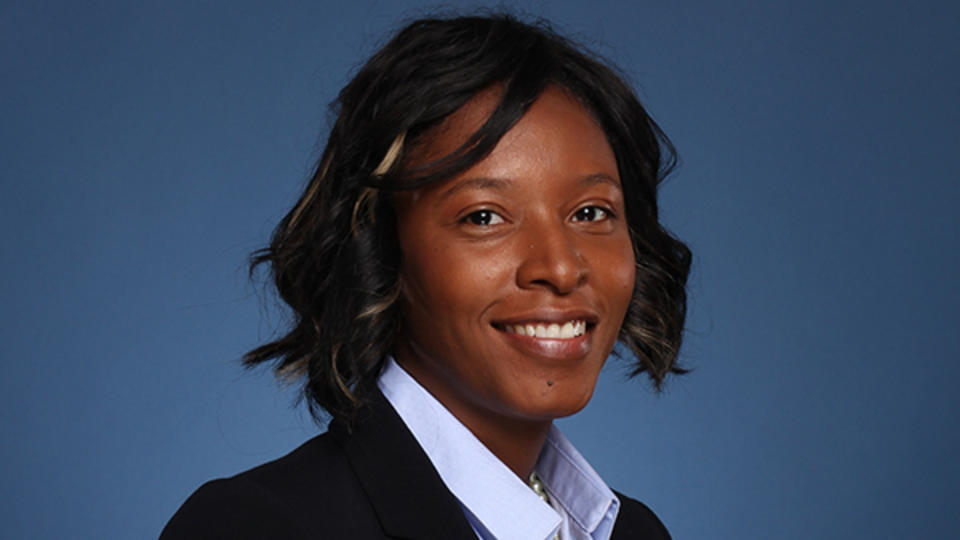
Owl Have You Know
Season 3, Episode 5
Natalie sits down with host Scott Gale ‘19 to discuss her early years working offshore with bp, her dreams of reaching the C-suite in the oil industry, working and living in China, and starting her own clothing business, Sisterly Village.
Subscribe to Owl Have You Know on Apple Podcasts, Spotify, Youtube or wherever you find your favorite podcasts.
Episode Transcript
-
[00:00] Intro: Welcome to Owl Have You Know, a podcast from Rice Business. This episode is part of our Pivot Series where guests share stories of transformation in their lives and careers.
[00:12] Natalie: So, definitely within the next five years, I'd like the introduction to move to “Welcome, we have Natalie Smith on the line. She's a partner at EY-Parthenon.” Yeah. So, that's my focus right now.
[00:30] Scott: Today on Owl Have You Know, I'm joined by Natalie Smith, 2017 graduate from the Rice Business full-time program. Natalie and I discuss how her Rice MBA experience helped facilitate her transition from a career in offshore oil and gas with BP to leading mergers and acquisition engagements with EY-Parthenon’s M&A Practice, and doing it all while raising kids and starting your own business on the side. Let's jump into the conversation with Natalie.
Natalie, how are you? Welcome to the show.
[00:59] Natalie: I'm doing well. Thank you. Thank you for the invitation. Happy to be here.
[01:04] Scott: Thrilled to have you here, really excited about the conversation. So, I just kind of want to dig right in. Early in your career, you worked for BP in the energy space. Can you tell us a bit about how you landed at BP to begin with, a little bit of just kind of that journey?
[01:20] Natalie: Yes, yes. So, I studied mechanical engineering originally and studied at Prairie View A&M University. It's a HBCU here, locally here in Houston, then went and got my master's degree in mechanical engineering from University of Michigan. While I was there, I was working at Ford and doing research. I graduated in 2008 and that was probably the worst time to graduate from master’s school. And working for Ford, it was probably the worst time. It was a recession. So, I knew that I didn't want to start my career off there. And so, I was like, okay, well, I can always go back home to Houston and enter the oil and gas industry. And so that's what brought me to BP. Yeah. I worked as an offshore engineer there for about six, seven years.
[02:11] Scott: Oh, wow. So, the entire, kind of, the time that you were there, you were doing offshore-related work?
[02:17] Natalie: Correct, correct. Worked on both facilities as well as vessels.
[02:22] Scott: Okay. Wow. Can you tell us a little bit about some of the standout experiences from being offshore for BP?
[02:29] Natalie: Sure. So, I mean, every experience you have, especially working offshore and subsea, is unique. So, some of the, I'd say, the standout experiences that I had, so the first time that I actually rode on a vessel, it took 10 hours from the coast of Louisiana inward to get to the facility.
And the first time that I went, it was a horrible storm. It was a, it was a horrible storm. And the boat was just rocking back and forth and all of the bunks and beds are below. And so, regardless of you being sleepy and have worked either a 12 to 16-hour shift, it's loud. The slams from the waves are, it's amazing. Yeah. And to be out there for that long, 10 hours just to get to the site. And then we were there on site for about two weeks. And working offshore, there's a rule. So, you can only be off shore for two weeks and then you have to touch land and then you have to come back to continue work.
So I was, this entire procedure that we were working on lasted five weeks. So, two times, we had to go, yeah, shuttle back to the coast and literally get off the boat, touch land and then get back on and go back out.
[03:59] Scott: Oh, wow.
[03:59] Natalie: Yeah.
[03:59] Scott: That's quite the experience.
[04:01] Natalie: So, those are some of the standout things that you wouldn't think happens. Yeah.
[04:06] Scott: From that experience, I mean, it's just my understanding of, I've not ever been on an offshore platform, but, you know, and for those that haven't that are listening, I suspect that there's, you know, an amount of preparation that's kind of required to be out on a platform. What are some of the things, hurdles, you had to, kind of, get over to be able to be out there and doing that kind of work? And are there any things that, you know, you kind of learned from that experience that sticks with you today?
[04:31] Natalie: Oh, definitely. So, there are quite a few certifications that you need in order to be able to go offshore. And I'd say the one that is most interesting is the HUET Training. It's the helicopter training. The helicopter training actually occurs within a pool. It's preparing you if the helicopter were to break down and, within the ocean, and teaching you how to survive, basically. And so, they teach you to bust through the window of the helicopter and slide through the window. You learn how to make your coveralls into floaties. And you learn, you know, the true weight of your steel toe boots and how to take those off, you know, to protect yourself. They put you in a pool that allows you to really, truly realize the temperature of the water. And so, they try to realistically prepare you.
[05:28] Scott: Simulate that experience.
[05:28] Natalie: Yeah. Yeah.
[05:29] Scott: Hopefully never had to put that into practice.
[05:31] Natalie: I never did. And I'm grateful for that, yeah, very much.
[05:35] Scott: So, in those six years, I mean, were you on just a single rig or lots of different platforms? Or how?
[05:41] Natalie: Right. Right. So, I did work on different platforms in different projects to actually create new facilities. I did quite a bit of, of work out there, worked with a lot of great people that I still admire to this day and connect with to this day. Yeah. BP was a great place.
[06:01] Scott: So, kind of with that foundation in energy and offshore, you were at BP when you started your full-time MBA program?
[06:11] Natalie: Well, let's take a step back. So, why even the MBA, right? So, I had always wanted to achieve a particular role, a business executive role, and be a part of the decision making, actually be around that table. And within the oil and gas industry, especially a company of the size of BP, it's very hard to reach that level. You could work 20 years and just be a manager. It's very hard to make it to a level where you're a part of the C-suite. And so with that in mind, I wanted to, one, get my MBA, but also transition to study, the study the aspects that would place me in those type of environments. And so, that's what brought me to Rice.
I did have an opportunity to study finance as well as entrepreneurship and through that, had an opportunity to do an investment banking internship with UBS during the summer. And that basically opened my eyes to mergers and acquisitions but also definitely gave me the validation that, yes, from now on, I will be a part of that environment where the folks who are responsible for making business decisions and have the authority to make the decisions. I'm always in the room now. Yeah.
[07:43] Scott: I love it. What did originally put Rice on your radar?
[07:46] Natalie: At that time, we were here in Houston obviously. I was working at BP and I was married. And also, we had our first son. And so, we were at a place where I knew that I couldn't move to another state in order to study for my MBA. I knew that it would need to be local. And so, Rice, from that point of view in regards to MBA to me is the, it's the top school here. It was a no-brainer for me. And they're phenomenal when it comes to finance and entrepreneurship. They have a wonderful department. In addition, they have a strong network, not only here in Texas, but nationally. And that's what I wanted to be able to walk away with.
[08:32] Scott: And so to do that, you stepped kind of out of your career to go do a full-time program. What were some of the challenges and experiences of balancing family with now the studies and sort of fully immersing yourself in that Rice experience?
[08:49] Natalie: Right, right. So, I did leave corporate and just solely focused on school. And my husband continued to work. So, I did get an opportunity to get a partial scholarship through Rice. My husband was still working. And both of us were supporting and still raising children. It was definitely a busy time, shall I say, you know. I could be in class and if something happened with my son, Dylan, then, you know, I may need to step away and go see him in class, you know, and, and make sure that he's okay. In addition, long nights to ensure that, you know, I still take my son and put him to bed. And then at night is when I study. It was, you know, just getting, becoming flexible and being in a position to adjust, but also being willing to put in the hard work to make sure that it was a success. Yeah.
[09:47] Scott: Yeah. Absolutely. No, that's fantastic. In the Rice experience, what was unanticipated in terms of, kind of, when you showed up and now you're in the middle of the experience, like something that was a surprise in a, I'll say, a good way? Like, what was, you knew that you wanted to go in, great school in Houston, but you're there. You know, your elbow's deep in, you know, finance and accounting and all this stuff but like, what kind of surprised you?
[10:15] Natalie: Yeah. So when I went to Rice, I was under the impression that I would end up being an investment banker. That was my goal. And I landed the internship and whatnot, and it didn't work out the way that I planned. And I pivoted to consulting. And I did not expect that. Actually, when I went to Rice and investment banking and consulting kind of start as far as the recruiting process, it starts immediately at the beginning. They were talking about consulting and I didn't really know much about it. I had my own, you know, assumptions about it, but I didn't foresee myself ever becoming a consultant. And it's a, it's amazing that I pivoted to consulting and made a full career out of it. Yeah. So that, that's the big, big surprise. Yeah.
[11:08] Scott: Was there sort of like a spark moment in that, where it was like consulting is now, like, hey, like, I'll think about that differently or sort of accept that as a, as a cool potential path. Was there sort of-
[11:19] Natalie: Right.
[11:21] Scott: … a moment-
[11:21] Natalie: It was.
[11:22] Scott: … or a conversation or a mentor?
[11:23] Natalie: It was. So, I had the assumption that consulting was only solving long-term company problems. And I didn't know that there was a perspective of consulting for M&A, for mergers and acquisitions, for transactions between businesses. And that opened my eyes. There's another aspect to this. And I definitely wanted to be a part of it. It interested me and I wanted the opportunity to see, you know, how I would like it, give it a try. And surprisingly enough, I'm enjoying it. Yeah.
[11:58] Scott: That's great. That's really cool. The front end of your experience, I understand that you attended like a pre-MBA boot camp in Shanghai. Is that right?
[12:05] Natalie: I did.
[12:07] Scott: I wanted to ask you just about, sort of like, what was the motivation for doing that? And if you could just kind of share a little bit about kind of what the experience of being in Shanghai was like for that?
[12:16] Natalie: That's a cool question. So, while I was attending Prairie View, I had attended a study abroad program in China. And it was specifically for Mechanical Engineering. And I studied at Wuhan University and focused on the language, the history, economics and also did a study, a research study on the Yangtze Dam. Through that experience, I had an opportunity to, one, improve my language and build on my vocabulary within Mandarin. In addition, learned how to write and just wanted to consume the culture as much as possible. And so, I loved that experience.
And I think up until that point, people definitely, who are my friends, colleagues, associates, they knew that I had now a connection to China and developed friends there and whatnot. When I was pursuing the MBA, a mentor of mine, Eric Lyons, had proposed to me that there's an opportunity for me to get a fellowship by attending this particular MBA program. And I was like, sign me up. Yeah. Like, this is, this is great. Yeah. This is right up my alley. So, that's what, actually I didn't even know about the program beforehand. He had introduced it to me and I was happy to participate in it. And it was phenomenal. I think it was a two-week program. They went through, you know, providing awareness about what you're about to embark upon for your MBA program. And so, it was perfect. I was not surprised when I attended Rice about what we were studying and things of that nature. It provided that initial awareness.
[14:11] Scott: Wow, that's amazing. Very cool. Have you had an opportunity to go back since then?
[14:16] Natalie: I haven't. That was the last time. Yeah. That was the last time but I, it is, it is on our bucket list. And I have always ensured that my children also kind of learn the language along-
[14:29] Scott: Oh, yeah.
[14:29] Natalie: … the way. So, it's a goal of mine that the family goes and that we are fully aware with we're able to communicate and get the most out of the experience. Yeah.
[14:38] Scott: I love it. That's fantastic. Thank you for sharing. I'm curious about – because you're with EY now in a consulting role. And so, as you kind of started to think about consulting differently, like, why EY? Like, what's been great about the experience coming on to EY and what drew you there?
[14:55] Natalie: Yeah, definitely. So when I was determining where I would be for my career post-Rice, I definitely recruited across multiple avenues and across multiple industries. And EY stood out very highly amongst the rest on a few different factors, diversity, in addition, just the culture. I've never felt secluded or isolated or ignored. My voice has always been appreciated and always been valued. And I didn't get that from all of the various places that I interviewed. As far as the culture, the fit, it worked perfectly. In addition, within the EY-Parthenon, the M&A practice of EY, they focus on a lot about the apprenticeship model and grooming, and that is what I desired and what I needed in order to thrive for my career. And so, I'm grateful for EY. Yeah.
[15:57] Scott: Okay. So Natalie, you're at EY now. You've had this ambition of being in investment banking and now you're there. You're senior director of mergers and acquisitions. What does somebody in that role at EY do?
[16:09] Natalie: Good question. So, within the EY-Parthenon practice, this is mergers and acquisitions. So, at a high level, we are responsible for supporting a company if they want to buy another company or even if a company wants to sell itself or a business unit to another company. And so, the senior director is now responsible for that entire aspect, owning the activities as well as the delivery of those deliverables, the products, in order for functions, each function, finance, marketing. You also have the operations, the supply chain, the manufacturing, all of those different aspects to run the, that particular business.
If a company's buying it and integrating it within their company, then we need to work with each of those particular functions and support them in this particular integration. That's more of the execution aspect but you also have the financial aspect, right, where I need to confirm that valuation. We may end up renegotiating numbers for the particular valuation and running a fairness opinion on the valuation. In addition, we'll do the due diligence to support operations as well as finance tax to ensure that we kick the tires on each of these specific areas and identify any risk or concerns that may come to life through this particular deal. So, that's what I do and I own that entire aspect of the deal. Yeah.
[17:56] Scott: Wow, that's exciting.
[17:58] Natalie: And the client relationship.
[17:59] Scott: Oh and doing it all while keeping everybody-
[18:02] Natalie: You're right.
[18:03] Scott: … happy.
[18:03] Natalie: Exactly. You got to keep people happy. Yeah.
[18:05] Scott: Well, I mean, what are some of the distinct challenges in that, in pulling that together?
[18:11] Natalie: I'd say the critical challenges is the fact that this is a people business. And so, there are multiple personalities and there are multiple agendas when it comes to transactions and ensuring that our clients win. And so, you want your client to win. You want them to know that the advice that we're providing them is trustworthy as well as credible. And so, we want to ensure that we maintain those type of relationships and provide that type of service to them as well.
[18:43] Scott: No, that makes sense. I suspect that there's probably a lot of people that are on the team to, kind of, pull all of those different kind of pieces together.
[18:52] Natalie: You'd be surprised. I've been on some engagements where if we're just doing a due diligence, it may just be four people. But I've been on other engagements where the execution aspect to actually realize the transaction or it may have very large teams up to, you know, a hundred, if not more.
[19:12] Scott: Oh, wow. I'm interested in just, kind of, the profile or the characteristics of people as you build out your team. Like, how do you think about putting the right team together and ensuring a positive outcome, given all of the different dynamics and challenges and the uniqueness of every deal? I'm sure every deal has its kind of own personality. Are there rules of thumb or things that kind of guide your team-building process?
[19:42] Natalie: It is. So, I like to build my teams really according to the motto that we have at EY. So, smart, driven, and nice. And everybody at EY, if you've made it there, you are very intelligent. So, as far as me questioning your intelligence, don't have to worry about that. Definitely want to have people a part of my team who are aware of and have experience within specific industries and sectors, in addition to making sure that they are self-starters and that's kind of where the driven piece comes from. Because with this particular job, you need to not only be aware of what the program plan is, but in order to execute it, you have to be a self-starter. Nobody's going to tell you, “Oh okay, today is, this is when this particular thing starts and this is how you do it.” You just have to have it. With that, that particular skill, you just have to have it within yourself and you go on your own, and you do it well.
And then lastly, as far as the nice piece, I like to work with people who are respectful, that have strong interpersonal skills, in addition, know how to be considerate of others. And that's where that nice piece comes from, because it not only works well within, internally, within our teams. But at the end of the day, we're providing a service. And so I need people who know how to be a servant to their client. And part of that is being nice.
[21:15] Scott: So, I want to just to shift a little bit because I want to talk about Sisterly Village and-
[21:21] Natalie: Okay.
[21:21] Scott: … kind of what inspired you to start that. If you could tell us what it is and kind of the mission and then why you started it.
[21:27] Natalie: Right. Right. So, I had started Sisterly Village while I was attending Rice. And I have a passion and affinity for retail, always have. And I would design my own garments as a child. With Sisterly Village, I wanted to develop a company that supported women's organizations and provided them attire that could make their lives very easy and wear professional attire that was very easy to put on. They would only need to zip it up and walk out the door, and they would look nice. And we would sell garments that were either for a group, like a chapter, or even individually. And the thought behind Sisterly Village was that it was a company that would always give back, a social enterprise.
With Sisterly Village, for every order that we, that you made, we would donate 7% of the proceeds back to an organization of your choice. And so, that could be with, you know, the organization that you just purchased for or that could be to another entirely different organization.
And so, I had this company from the time that I graduated from Rice, leading up to COVID. Through COVID, obviously, with that, you know, thought process for the business, there was no need any longer for attire for women's organizations. Many conferences were canceled, right when COVID started. Therefore, there was no, you know, no need to look alike. In addition, many people took a pause on spending money on just purchasing attire. Many folks were just staying at home and there really wasn't a need to continue to buy attire to look nice to go somewhere. So…
[23:31] Scott: Demand for sweatpants went up.
[23:32 Natalie: Exactly, exactly. A lot of athleisure went up. And so, through that, I put my store on pause. So, it did very well, but I'm glad I took a pause when I took a pause because otherwise-
[23:47] Scott: That make sense. No, that's cool.
[23:47] Natalie: … I think the story would be different.
[23:48] Scott: What are the things that you've learned of from that experience and kind of-
[23:51] Natalie: Oh, many things.
[23:51] Scott: … just standing up your own business, winding it down a little bit. And it sounds like it's maybe on, kind of, the back burner. I don't know. But like, what are some of the things that stand out from having done that work?
[24:00] Natalie: Right, right. So, I'm very clear on the end-to-end process of designing garments to selling garments. And what I mean is the design process, the manufacturing process, the logistics process, the distribution process, and even the marketing process, the return aspect with your clients, your customers, and ensuring that your, your customers feel like they received a quality product and would love to continue to purchase from you. Through Sisterly Village, I learned it and there were areas where things weren't perfect and learned how to perfect it and improve it.
In addition, the sales aspect, so with our company, the goal is to have basically a client relationship with women's organizations. And so, it put me in a position where I now needed to pitch and sell my company to these particular women's organizations and get their buy-in in order to be able to sell product to their organizations.
Many of these women's organizations have contracts in place with approved vendors and only work with specific vendors for their attire because they have, obviously, trademarks. They also have crests and whatnot that they've copyrighted and, and have protection over. And so, they only work with approved vendors that they know will make a quality product, ensure that the emblems are done tastefully and accurately. And so, we were approved by many women's organizations. And so, that's something that I'm, I'm very proud of.
[25:51] Scott: Oh, that's very cool. Looking ahead, you know, into your crystal ball, what's like the next five to 10 years? You know, what's the next big goal that you want to kind of go tackle and take on?
[26:03] Natalie: Right. So, definitely within the next five years, I'd like the introduction to move to “Welcome, we have Natalie Smith on the line. She's a partner at EY-Parthenon.” Yeah. So, that's my focus right now.
[26:19] Scott: Very cool. You're a Houston native, Texas native. Like, what do you love about being in Houston?
[26:26] Natalie: Houston is a very busy place. In addition, I like the Southern hospitality aspect, the ability to meet so many different people. It's, you know, obviously, I'd say the most diverse place in the nation and large at that. I'd say that's how we compare against New York but we're very wide. I appreciate the ability to have to drive places. I couldn't foresee myself living in a city where I have to ride a train. And so, definitely, Houston's home. And it probably will always be home.
[27:04] Scott: I love it. Just kind of as we wrap up, any advice that you would give for people considering coming to Houston, participating in the Rice program. What advice would you give, given your journey and where you've been?
[27:18] Natalie: Advice for just coming to Houston, be prepared for the heat. And trust me, everybody complains. If you've lived here, grew up here, you’re still complaining about how hot it is compared to, you know, the people who've just moved. Everybody does not like-
[27:32] Scott: This is being recorded in August.
[27:31] Natalie: … how hot it is. Exactly, yeah. It's hot. Yeah. For folks who are interested to attain their MBA, and, and are considering Rice, I definitely think that you couldn't go wrong with that decision. Rice is a phenomenal school and one of the best when it comes to offering scholarships. You definitely will receive a quality education.
In addition, we're known for, you know, small cohorts. So, the relationships that you build are a lot stronger. You know everybody and everybody knows you very well and your family. Many of my classmates, they've looked after my children and we still, you know, hang out to this very day and help each other with their careers as well.
And those are the reasons, the network, are a lot of the reasons why I went to Rice. You definitely can't go wrong if you want to be a Owl.
[28:26] Scott: I love it. Natalie Smith, 2017 full-time program Rice Business alum, thank you for being on the show with us today.
[28:33] Natalie: Thank you so much. It was an honor.
[28:37] Scott: Thanks for listening. This has been Owl Have You Know, a production of Rice Business. You can find more information about our guests, hosts, and announcements on our website, business.rice@edu. Please subscribe and leave a rating wherever you find your favorite podcasts. We'd love to hear what you think. The hosts of Owl Have You Know are myself, Scott Gale, and Maya Pomroy.
You May Also Like
Fixing Methane Leaks May Help Solve Climate Change
Reducing Emissions can Have a Fast Impact on Lowering Global Temperatures


By Professor Jim Krane, originally published in The Conversation
Reducing Emissions can Have a Fast Impact on Lowering Global Temperatures
What’s the cheapest, quickest way to reduce climate change without roiling the economy? In the United States, it may be by reducing methane emissions from the oil and gas industry.
Methane is the main component of natural gas, and it can leak anywhere along the supply chain, from the wellhead and processing plant, through pipelines and distribution lines, all the way to the burner of your home’s stove or furnace.
Once it reaches the atmosphere, methane’s super heat-trapping properties render it a major agent of warming. Over 20 years, methane causes 85 times more warming than the same amount of carbon dioxide. But methane doesn’t stay in the atmosphere for long, so stopping methane leaks today can have a fast impact on lowering global temperatures.
That’s one reason governments at the 2022 United Nations climate change conference in Egypt focused on methane as an easy win in the climate battle.
So far, 150 countries, including the United States and most of the big oil producers other than Russia, have pledged to reduce methane emissions from oil and gas by at least 30%. China has not signed but has agreed to reduce emissions. If those pledges are met, the result would be equivalent to eliminating the greenhouse gas emissions from all of the world’s cars, trucks, buses and all two- and three-wheeled vehicles, according to the International Energy Agency.
There’s also another reason for the methane focus, and it makes this strategy more likely to succeed: Stopping methane leaks from the oil and gas industry can largely pay for itself and boost the amount of fuel available.
Capturing methane can pay off
Methane is produced by decaying organic material. Natural sources, such as wetlands, account for roughly 40% of today’s global methane emissions. But the majority comes from human activities, such as farms, landfills and wastewater treatment plants – and fuel production. Oil, gas and coal together make up about a third of global methane emissions.
In all, methane is responsible for almost a third of the 1.2 degrees Celsius (2.2 degrees Fahrenheit) that global temperatures have risen since the industrial era.
Unfortunately, methane emissions are still rising. In 2021, atmospheric levels increased to 1,908 parts per billion, the highest levels in at least 800,000 years. Last year’s increase of 18 parts per billion was the biggest on record.
Among the sources, the oil and gas sector is best equipped to stop emitting because it is already configured to sell any methane it can prevent from leaking.
Methane leaks and “venting” in the oil and gas sector have numerous causes. Unintentional leaks can flow from pneumatic devices, valves, compressors and storage tanks, which often are designed to vent methane when pressures build.
Unlit or inefficient flares are another big source. Some companies routinely burn off excess gas that they can’t easily capture or don’t have the pipeline capacity to transport, but that still releases methane and carbon dioxide into the atmosphere.
Nearly all of these emissions can be stopped with new components or regulations that prohibit routine flaring.
Making those repairs can pay off. Global oil and gas operations emitted more methane in 2021 than Canada consumed that entire year, according to IEA estimates. If that gas were captured, at current U.S. prices – $4 per million British thermal unit – that wasted methane would fetch around $17 billion. The IEA determined that a one-time investment of $11 billion would eliminate roughly 75% of methane leaks worldwide, along with an even larger amount of gas that is wasted by “flaring” or burning it off at the wellhead.
The repairs and infrastructure investments would not only reduce warming, but they would also generate profits for producers and provide direly needed natural gas to markets undergoing drastic shortages due to Russia’s invasion of Ukraine.
Getting companies to cut methane emissions
Motivating U.S. producers to act has been the big hurdle.
The Biden administration is aiming for an 87% reduction in methane emissions below 2005 levels by the end of the decade. To get there, it has reimposed and strengthened U.S. methane rules that were dropped by the Trump administration. These include requiring drillers to find and repair leaks at more than 1 million U.S. well sites.
The U.S. Inflation Reduction Act of 2022 further incentivizes methane mitigation, including by levying an emissions tax on large oil and gas producers starting at $900 per ton in 2024, increasing to $1,500 in 2026. That fee, which can be waived by the Environmental Protection Agency and doesn’t affect small producers or leaks below 0.2% of gas produced, is based on the social cost to society from methane’s contribution to climate damage.
Customers are also putting pressure on the industry. Regulatory indifference by the Trump administration to U.S. methane flaring and venting led to cancellation of some European plans to import U.S. liquefied natural gas.
Reducing methane isn’t always straightforward, though, particularly in the U.S., where thousands of oil companies operate with minimal oversight.
A company’s methane emissions aren’t necessarily proportional to its oil and gas production, either. For example, a 2021 study using data from the EPA found Texas-based Hilcorp Energy reporting nearly 50% more methane emissions than ExxonMobil, despite producing less oil and gas. Hilcorp, which specializes in acquiring “late life” assets, says it is working to reduce emissions. Other little-known producers have also reported large emissions.
Investor pressure has pushed several publicly traded companies to reduce their methane emissions, but in practice this sometimes leads them to sell off “dirty” assets to smaller operators with less oversight.
In such a situation, the easiest way to encourage companies to clean up is via a tax. Done right, companies would act before they had to pay.
Using technology to keep emissions in check
Unlike carbon dioxide, which lingers in the atmosphere for a century or more, methane only sticks around for about a dozen years. So, if humans stop replenishing methane stocks in the atmosphere, those levels will decline.
A review of methane leaks in the Permian Basin shows the big impact that some regions can have.
Researchers found that gas and oil operations in the Permian, in west Texas and New Mexico, had a leakage rate estimated at 3.7% in 2018 and 2019, before the pandemic. A 2012 study found that leakage rates above 3.2% make climate damage from using natural gas worse than that from burning coal, which is normally considered the biggest climate threat.

Methane leaks used to escape detection because the gas is invisible. Now, the proliferation of satellite-based sensors and infrared cameras makes detection easy.
Companies such as GTI Energy’s Veritas, Project Canary and MiQ have also launched to assist natural gas producers in reducing emissions and then verifying the reductions. At that point, if leaks are less than 0.2%, producers can avoid the federal fee and also market their output as “responsibly sourced” gas.![]()
Jim Krane, Fellow for Energy Studies, Baker Institute for Public Policy; Lecturer in Management – Energy, Jones Graduate School of Business at Rice University
Never Miss A Story
You May Also Like
Keep Exploring
OMBA Ranking 2023: Average GMAT, GRE & GPAs For The Top Online MBA Programs
Entrance exams are not as ubiquitously required among the leading online MBA programs as they are in traditional master’s of business administration programs. Rice Business ranks among other schools with the top GMAT scores.

Houston research: The future of decision making in energy operations
Rice Business professor Nicola Secomandi, along with University of Illinois at Chicago College of Business Administration professor Selvaprabu Nadajarah, were recently invited by the European Journal of Operational Research to conduct a review of the operations literature on real options in energy.

How To Chart a Path to a Consulting Career
Consulting is one of the most popular career paths for Rice MBA graduates, and for good reason. Not only is it lucrative, consulting enables you to put creative problem-solving into action to help businesses succeed. As the No. 10 Best MBA for Consulting (Princeton Review, 2022), Rice MBA graduates find success in consulting.
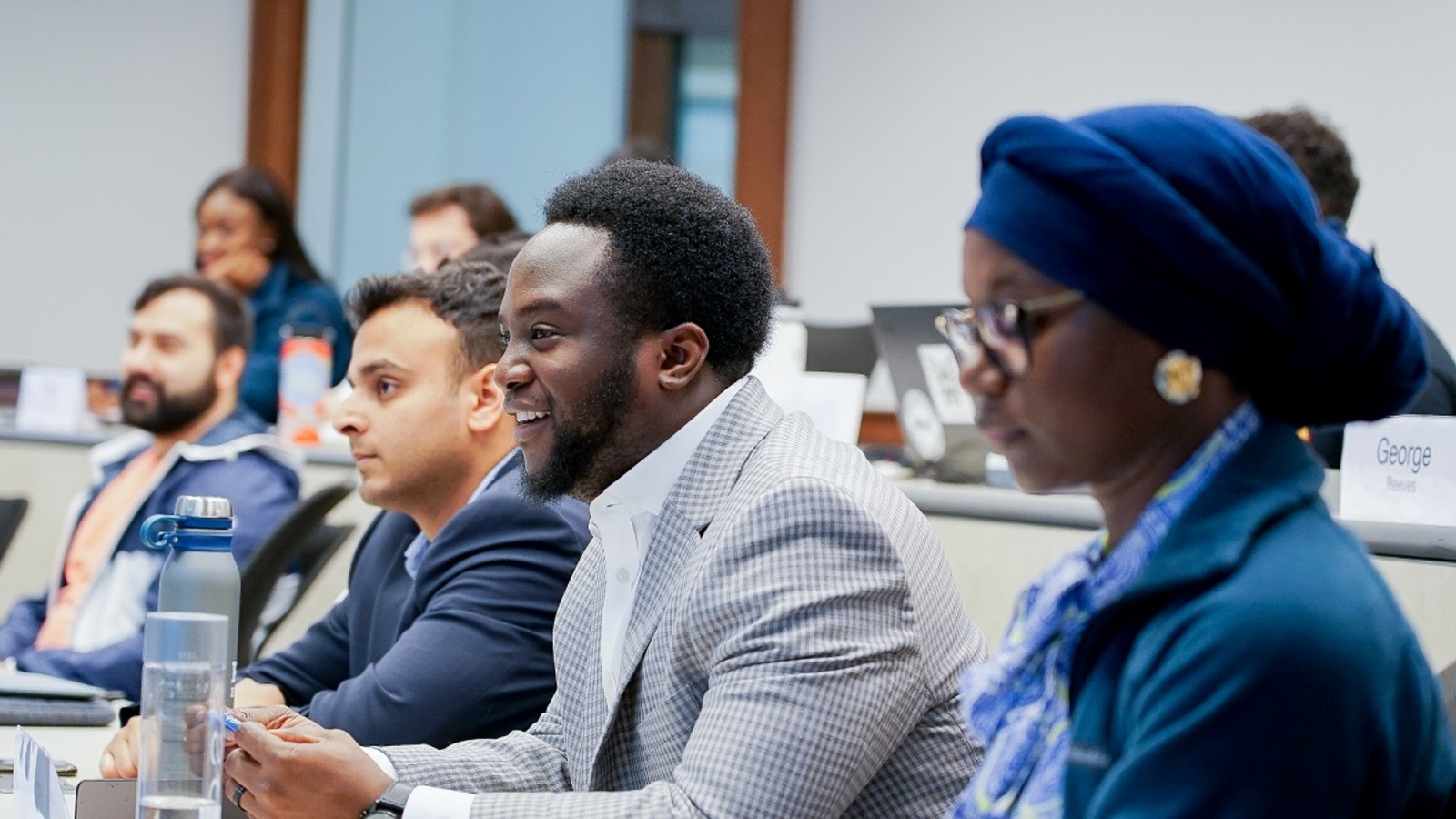
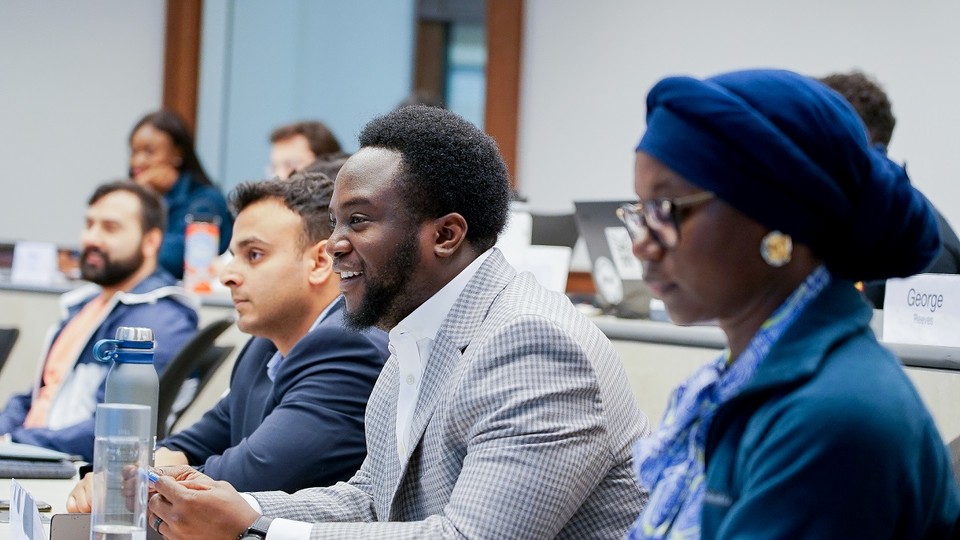
Updated from original post that was published on 11/21/2022.
How to Chart a Path to a Consulting Career
Consulting is one of the most popular career paths for MBA graduates, and for good reason. Not only is it lucrative, with salaries around $176,000, consulting enables you to put creative problem-solving into action to help businesses succeed. At Rice Business, you’ll find four key advantages that prepare you to launch and thrive in a consulting career.
1. Design a Curriculum That Aligns with Your Goals
At Rice Business, your rigorous, STEM-designated coursework will help you cultivate the problem-solving skills that companies are looking for. That’s just one part of being a knowledgeable consultant, though. Rice’s customizable curriculum is designed to emphasize the soft skills required to be successful in consulting. This structure allows you to focus on multiple strengths and build up your experience to put you ahead when you graduate.
2. Join a Program with a Strong Consulting Track Record
In 2024, 20% of the Full-Time MBA graduating class at Rice Business entered the consulting industry after graduation — making it second-largest employment industry for that class. They have been hired by Accenture, FTI Consulting, McKinsey & Company, Deloitte Consulting, Boston Consulting Group, L.E.K. Consulting and EY-Parthenon, to name a few.
Getting the right degree at a top-ranked business school with a tight-knit culture is important for building connections needed for a consulting career.
Interested in Rice Business?
3. Leverage Experiential Learning to Set You Apart
Just one of the reasons Rice is one of the top-ranked MBA programs for consulting is the unlimited experiential learning opportunities that give you plenty of inspiration for the personal experience portion of a consulting interview
The Rice Business Board Fellows connects Rice MBA students with nonprofit boards to create positive change in the Houston community, with a goal of developing the next generation of leaders for the city’s nonprofits. By participating in this year-long program, you’ll serve on a local nonprofit board as a non-voting member, with a front row seat to how to make an impact on a board. And it isn’t only the students that benefit from the Board Fellows program. The local organizations gain a fresh perspective from the students as they look to solve problems or improve their organization.
As part of the core curriculum, professional and online MBA students at Rice Business take the Capstone Course, a consulting project that enables students to help community organizations in the Houston area. The MBA students work in teams to craft recommendations for organizations that are undergoing major growth or expansion plans or developing turnaround strategies, as well as new ventures in need of business plans.
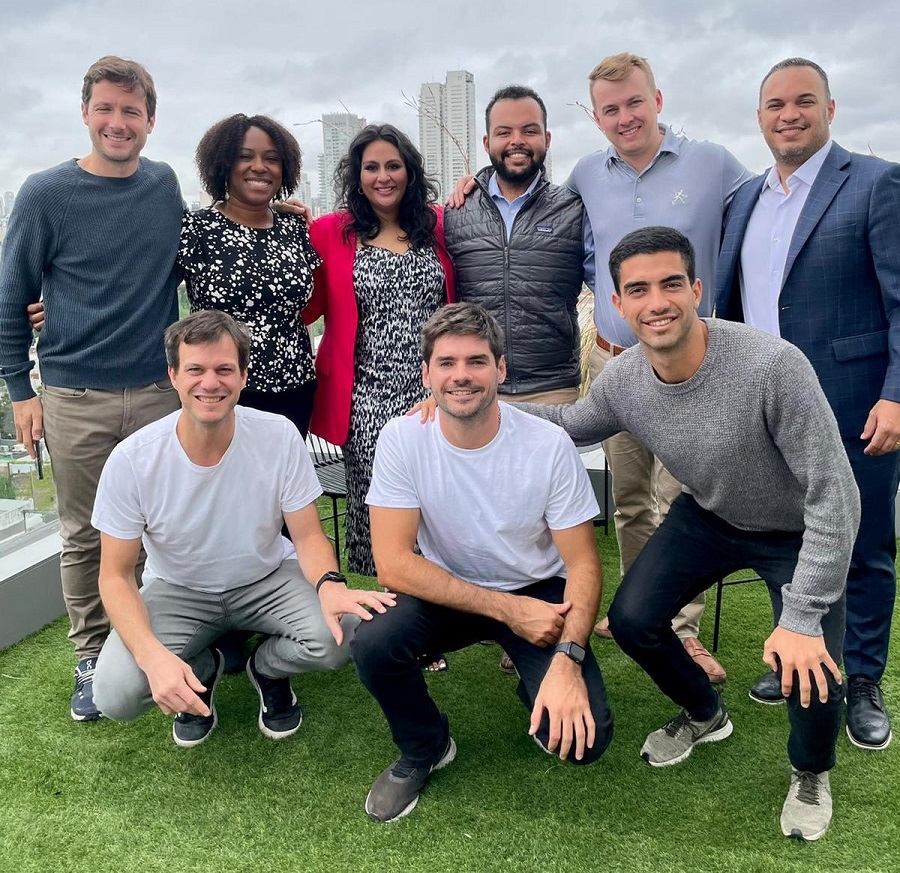
Finally, students travel to another country for an immersive international learning experience built into the core curriculum for all MBA programs, including the online MBA. The Global Field Experience lets you take what you learn in the first year of the program and apply it to short-term consulting projects for organizations and communities in diverse cultural settings. Students are paired with a local business abroad — we work with 250 companies per year, usually a small business or entrepreneur — to solve real problems such as growth strategy and market expansion projects.
The Rice Business Board Fellows, the Capstone Course and the Global Field Experience are just a few of the experiential opportunities offered at Rice Business that will help set you apart in your interviews.
4. Tap Into a Network That Has Your Back
The Consulting Association, one of our student-led clubs, is dedicated to helping its members succeed in the consulting field. Through workshops, team practices and intra-school competitions, you can improve your skills at case analysis and interviewing. Plus, the club has a network of consulting and business leaders that you can learn from at their social events.
You also get support from our Career Development Office (CDO). Career coaches help you refine your behavioral interview stories to reflect your unique personal experience. You can also book time with an advisor to practice your interview skills and get feedback. Additionally, two Rice Business alums who went on to work at BCG and McKinsey (Matthew Thurman and Ryan Heider) developed a 10-week workshop, WayFinder, to help our students master case interviews. You can access the training for help with the problem-solving portion of consulting interviews.
These academic, experiential learning and social opportunities and strong career support from the CDO will set you apart amongst a competitive field of aspiring consultants. Finding a consulting job doesn’t have to be stressful, with the support and foundation you’ll get here at Rice Business. You can learn more about our career outcomes here.
You May Also Like
Keep Exploring
The Evolution of ESG Reports and the Role of Voluntary Standards
A paper co-written by Kunal Sachdeva, Assistant Professor of Finance at Rice Business, examines the evolution of ESG reports for S&P 500 companies and explores how the content of ESG reports has evolved in the absence of regulation.
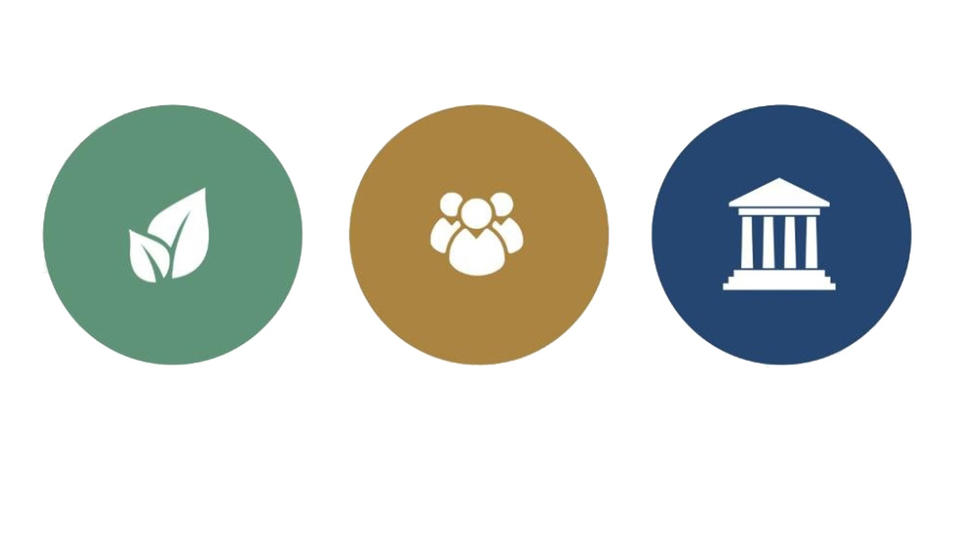
Rice Business launches new organizational behavior Ph.D. program
Rice Business will offer a Ph.D. with a concentration in organizational behavior starting next fall. The deadline to apply is Jan. 13, 2023.


Rice Business will offer a Ph.D. with a concentration in organizational behavior starting next fall. The deadline to apply is Jan. 13, 2023.
The field of organizational behavior addresses topics such as leadership, power and influence, teams, networks, emotions, cognition, diversity, motivation and trust, as well as employee well-being, ethical decision-making and social justice. The new doctoral program’s broad interdisciplinary training will prepare students to draw from psychological and sociological perspectives to research the complexities of organizations and organizational life, focusing on the structures, environments and mechanisms that impact behavior.
“Organizational behavior faculty are at the forefront of research and teaching on the growing challenges of a modern workforce in a complex world,” said Scott Sonenshein, Rice Business’ organizational behavior area coordinator and a New York Times bestselling author. “Our program will invest in and train the next generation of professors so their research and teaching helps organizations become more effective, innovative, equitable and humane.”
The new concentration in organizational behavior joins existing Rice Business doctoral programs in accounting, finance and strategic management. The programs are intended for those aspiring to become faculty members at business schools at prestigious research universities. Doctoral students engage in coursework, teaching preparation and high-quality research at multiple levels of analysis.
You May Also Like
How to Survive and Thrive on an Online MBA
George Andrews, associate dean of degree programs at Rice Business, advises students to set up a designated workspace, and schedule time outside of class to study, prepare assignments and meet with their team for group projects.

The Consortium Grows Again: Kellogg Becomes 23rd Member B-School
The Consortium, whose members include Rice Business, has had a mission of the promotion of diversity, equity, and inclusion in graduate business education and American business since 1966.
